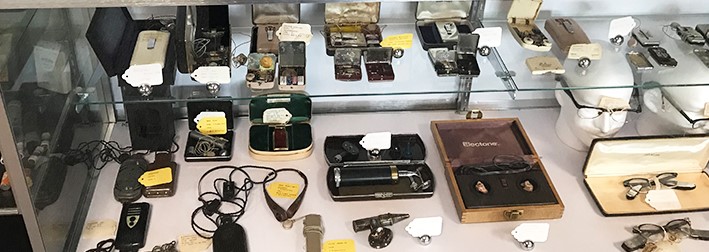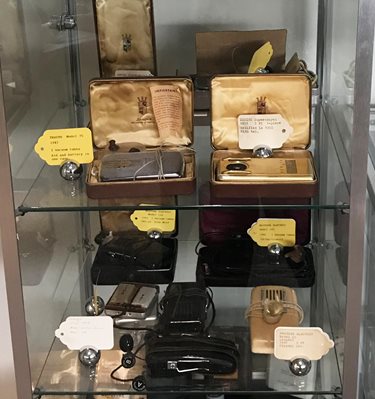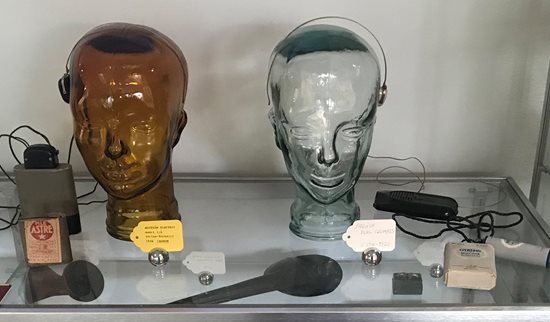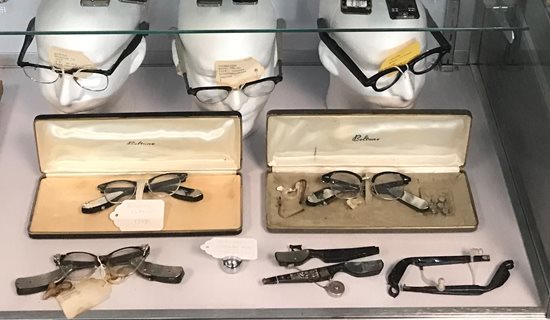
Over the years, hearing aid technology, functionality and effectivity has been dramatically enhanced especially with up-and-coming research. As a result of these advancements and modifications, patients who require hearing aids have an increased quality of life and more treatment options available.
With expert audiologists and comprehensive technology, the Pennsylvania Ear Institute (PEI) of Salus University is equipped with everything you would expect from a modern and state-of-the art audiology facility. However nestled unassumingly to the side of the waiting room, you’ll also find a little piece of the past – a history display of hearing device equipment that spans through the years.
Below you will learn more about the history of hearing device equipment and technology developments from Dr. Victor H. Bray.
The remarkable display, a timeline of technology spanning 150 years, was developed by Dr. Victor H. Bray, associate professor and former dean of Salus University’s Osborne College of Audiology, who also was interim director of PEI for several years.
“When I came here as dean of the College in 2009, I started soliciting information of historic interest to audiology,” he said. “This collection was built with several donations and some devices go back 150 years to the late 18th century.”
 Centuries prior, people with hearing loss created make-shift devices by hallowing out the horns of rams, cows and other animals. It wasn’t until the 18th century that devices such as the ear trumpet were developed. With its funnel-shaped design, ear trumpets were one of the first forays into modern hearing device technology as it is known today.
Centuries prior, people with hearing loss created make-shift devices by hallowing out the horns of rams, cows and other animals. It wasn’t until the 18th century that devices such as the ear trumpet were developed. With its funnel-shaped design, ear trumpets were one of the first forays into modern hearing device technology as it is known today.
“Essentially all people had was a horn to collect sound and the sound would funnel down a narrow tube into the small piece that went into the ear,” said Dr. Bray. “It would provide a small boost of sound but that was the only technology at the time.”
The invention of the telephone coupled with the increasing use of electricity helped spawn the creation of the electric hearing aid in 1898. The early iteration of the electric hearing aid was carbon-based and came with three parts – the battery, the microphone and the transmitter.
“The microphone would be worn attached to your clothing and it would pick up the sound. The sound would come through the battery and then be amplified and transmitted to the person’s ear,” said Dr. Bray.
By the early 1920s, hearing aids were being made using vacuum tubes. Because vacuum tubes controlled the flow of electricity better than carbon, these devices provided increased sound levels. However there was one downfall: their size. These devices started out very large but by the mid-1920s, they were small enough so that the main components could fit in a small wooden box while the receiver could be put up to the ear.
Thanks to advancements made during World War II, during the late 1940s, the production of hearing aids made with circuit boards and button-sized batteries allowed all of the necessary functional components to fit into a pocket-sized unit. Although it was designed to be discreet and much smaller, visible wires were required to connect the unit to the earpiece.
The next decade ushered in the age of transistors and hearing aids shrunk in size yet again. Body-worn hearing aids became increasingly common. The portion of the hearing aid worn on the body contained the battery pack and the microphone while the receiver portion was worn in the ear.
 “Because people were wearing these and they had to be shown, there was an effort to make them cosmetically appealing,” said Dr. Bray. “Design was a very important part of these hearing aids. Many had beautiful, intricate designs on them.”
“Because people were wearing these and they had to be shown, there was an effort to make them cosmetically appealing,” said Dr. Bray. “Design was a very important part of these hearing aids. Many had beautiful, intricate designs on them.”
During this time period, there was a major quest to create a way for hearing aids to be worn off of the body and on a person’s head. This came at a crucial time in history when the professions of audiology and optometry intersected. From that came the creation of eyeglass hearing aids.
“Back in the 1950s and 1960s, there were a lot of places that handled hearing and vision together,” he said. “It was nice to have audiology and optometry practices working together.”
With eyeglass hearing aids, the temple pieces on the sides of the glasses were used to hold hearing aids in place on the head – an innovation that at the time was considered very state-of-the-art.
“Now you could actually wear two hearing aids at the same time,” said Dr. Bray. “Often with the body-worn hearing aids, it was just amplifying one ear but now with the head worn device, you could amplify both ears.”
As time progressed, one-piece devices worn behind the ear eventually began to emerge. This more commonly recognizable style is known as a behind-the-ear hearing aid. Originally bulky and noticeable, now behind-the-ear hearing aid styles have become progressively smaller and better in quality.
“The quality of sound is now tremendous. What we have now is far more powerful then what we could do with vacuum tubes and body-worn hearing aids,” Dr. Bray said. “Now the fidelity, bandwidth of sound, the quality of sound, the lack of distortion - all of it is just tremendous.
 Today, technology has now become enhanced to the point that hearing aids are made in many different types, styles, colors and with numerous programs - all of which can be customized to meet the needs of each person being fitted with hearing devices.
Today, technology has now become enhanced to the point that hearing aids are made in many different types, styles, colors and with numerous programs - all of which can be customized to meet the needs of each person being fitted with hearing devices.
“Now the two little hearing aids can be matched up with your smartphone - your phone and your hearing aids are connected, they are all working together,” said Dr. Bray.
Looking back at the last 150 years of enhancements and developments, according to Dr. Bray, the future of hearing device technology and the field of audiology as a whole is very bright.
“There are discoveries being made in basic sciences which turn into new diagnostic tools and our students are taught to stay current because every 10 years or so there’s going to be another breakthrough in a diagnostic tool,” he said. “When I think about what we can do with these, the benefit our patients can receive, each one of these steps of technology changes is a significant step forward.”